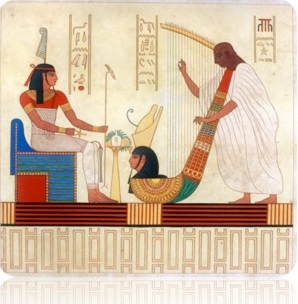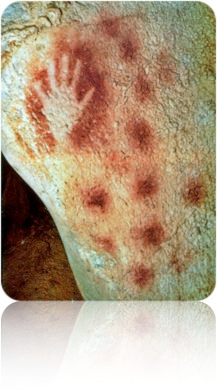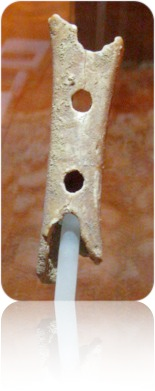How did music begin? What did the first music sound like?
Music is all around us and is a large part of many of our lives. It exists in every culture across the globe. Yet, we often don't stop to think about how music came to occupy this position. Who first thought of music? Who produced the first melodies and songs? How did music develop as such an important aspect of our lives? The search for answers to these questions leads us thousands of years into the past.
Harper playing before Shu
Scholars from around the world are trying to learn more about the first types of music, the instruments that created that music, and what role music had for early humans. In 2009, a group of researchers unearthed a primitive flute made from a hollow bone of a griffon vulture. The flute is thought to be 35,000 to 40,000 years old, and it is possible that it was made by Neanderthals, who lived during this time period in the part of Germany where the flute was found. The flute had five air holes along the hollow tube, and scholars say that the flute would have been capable of playing complex melodies. An experimental archaeologist even made a reproduction of the flute and was able to play 'The Star Spangled Banner' on it.
While this finding was a rare one, scholars have found a few other flutes that appear to be this old or maybe even older. Yet, the music and world of these early human ancestors are still largely a mystery to us. Findings like the flutes help us to learn more about not only the music of prehistoric peoples but also the lives that they lived.
Prehistoric, or primitive, music includes all music created in preliterate cultures. Thus, prehistoric music includes the first types of music ever created or played. Because the groups producing this music did not leave a written record for us, we know much less about the early music produced than we do about later music. The reality is that we don't really know who first created music or how they came to create that music. What we do know comes from archaeological research and other evidence such as cave paintings. Archaeomusicology is the use of archaeological techniques in the study of music. This area of study uncovers and analyzes evidence related to music. Scholars also try to trace early forms of music to see how they have influenced later forms of music.
There are a number of theories about how music developed. Some scholars argue that music developed from the natural sounds and rhythms around early peoples. This might have included everything from bird calls to a person's heartbeat. Humans often try to mimic the sounds that we hear, so it would be natural for early humans to also mimic the sounds that they heard around them, whether it was the chirp of an insect or the roar of an animal. If this is the case, early music was likely simple sounds that were repeated. It may have been used not only for the enjoyment of mimicking the sounds, but also to create reactions from animals during hunting (either calling animals to them or getting them to respond with their own calls).
From Pech Merle
Since early peoples did not have most of the instruments that we now have, they had to create music in other ways. Likely, voices were one of those instruments. In fact, archaeologists have found evidence that prehistoric peoples may have placed marks on the walls and ceilings of some caves in order to note special acoustics in the cave. For example, Pech Merle is a French cave that has red dots on the ceiling to note these special acoustic spots in the cave. There are also similar red dots on some of the walls. These spots seem to note places where sound would best echo and carry through the cave. It may be that prehistoric people used their voices or other items in these spots to fill the cave with sound. Some studies on French caves have suggested that many of the cave paintings, in addition to marks like the red dots, appear at places in the cave where the natural echo is strong.
There is also some indication that early people also created rhythms and sounds using created instruments. While these instruments may have been primitive compared to some of the instruments created and used today, they fulfilled the same purposes that instruments do in our lives. While the earliest music may have been created by voices, it is likely that prehistoric people also created rhythms or beats by hitting things together. This may have been anything from clapping their hands together to hitting a piece of wood on a rock. Humans were using tools 100,000 years ago, so it is likely that the sound of these tools would also inspire similar sounds in music.
Divje Babe flute
Until recently, scholars believed that voices and early 'drums' were the primary instruments used during prehistoric times. However, in the late 1990s, scholars uncovered a flutelike artifact that had been created from the bone of a cave bear. The Divje Babe flute was found in Slovenia and it appears to date to about 50,000 years ago. With several holes in the flute, the player could vary the tone of the sound when blowing air through the instrument. Whether used as a musical instrument or a whistle, the flute does create sound and flutes like this represent one of the first musical instruments. Most of the flutes that have been uncovered from early periods of human history are made of bone and hollowed out to allow air to pass through. The simplest of these instruments allows someone to blow air into one end, producing a musical sound or note as the air passes through and exits the instrument at the other end. More complex examples resemble modern-day recorders and flutes, with holes on the top or sides of the bone. This allowed humans to create different tones by covering one or more of the holes when they blew air into the instrument.
